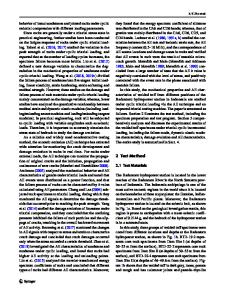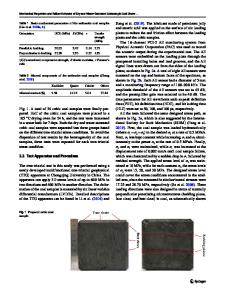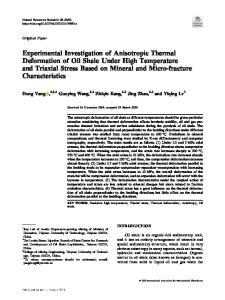Mechanical Properties of Bentonite-Sand Mixtures Under Triaxial Stress Condition
- PDF / 308,426 Bytes
- 5 Pages / 414.72 x 648 pts Page_size
- 74 Downloads / 299 Views
MECHANICAL PROPERTIES OF BENTONITE-SAND MIXTURES UNDER TRIAXIAL STRESS CONDITION M. UMEDERA, A. FUJIWARA", N. YASUFUKU"', M. HYODO"" AND H. MURATA"" Mining Co., Ltd., 2-16-9, Kabukicho, Shinjuku-ku, Tokyo 160, Japan "Sumitomo Metal ".Radioactive Waste Management Center, 2-8-10, Toranomon, Minato-ku, Tokyo 105, Japan ""Yamaguchi University, Tokiwadai, Ube-shi, Yamaguchi 755, Japan ABSTRACT A series of triaxial compression tests is being conducted under the drained condition on bentonite and sand mixtures, known as buffer, in saturated and optimum water content states to clarify the mechanical properties of the buffer. It was found that the mechanical properties of bentonite and sand mixtures are strongly influenced by water and bentonite contents: shear strength in a saturated state is less than that in an optimum water content state; shear strength decreases rapidly with increasing bentonite content. Strength properties are much dependent on confining pressure. INTRODUCTION In the underground disposal for relatively high radioactive wastes, bentonite and sand mixtures are expected to be used as a buffer material to construct low permeable layers and back-fills. Buffer layers and walls surrounding concrete silo will be constructed by compacting bentonite and sand mixtures at the silo type repository[I]. To assess the structural stability of repository components, it is necessary to predict the mechanical behavior of the buffer. However the mechanical behavior of bentonite and sand mixtures was not apparent at the beginning of this study. Thus studies as to the mechanical properties of bentonite and sand mixtures were initiated to assist in developing a numerical model and in determining experimental parameters for numerical analysis. The buffer will be in a partially-saturated condition during the construction and operation phases of the repository. From the closure phase, bentonite particles will swell during water percolation through the buffer material. Since the mechanical behavior of bentonite and sand mixtures was assumed to be dependent on water content, a series of triaxial compression tests was conducted on optimum water content and saturated specimens under the drained condition. TEST METHODS Materials for test specimen The sand component is Mikawa Keisa quartz sand with grain size distributed in the limited range of 0.1 to 2.0 mm. Bentonite is Kunigel V1, sodium bentonite produced at Tsukinuno Mine in Japan, containing 46 to 49% montmorillonite, 29 to 38% quartz or chalcedony, and smaller amounts of plagioclase, calcite, dolomite, analcime and pyrite[2]. Three kinds of bentonite and sand mixtures are being used in this series of tests; the weight ratios of bentonite to sand are 10:90(10% bentonite), 20:80(20% bentonite) and 30:70(30% bentonite). Fig.1 shows the grain size distribution curves of Mikawa Keisa quartz sand and 10%, 20% and 30% bentonite specimens. Specimen Preparation Standard compaction tests were conducted according to JIS A1210: each of the three layers in a 10 cm mold was compacted by 25
Data Loading...











